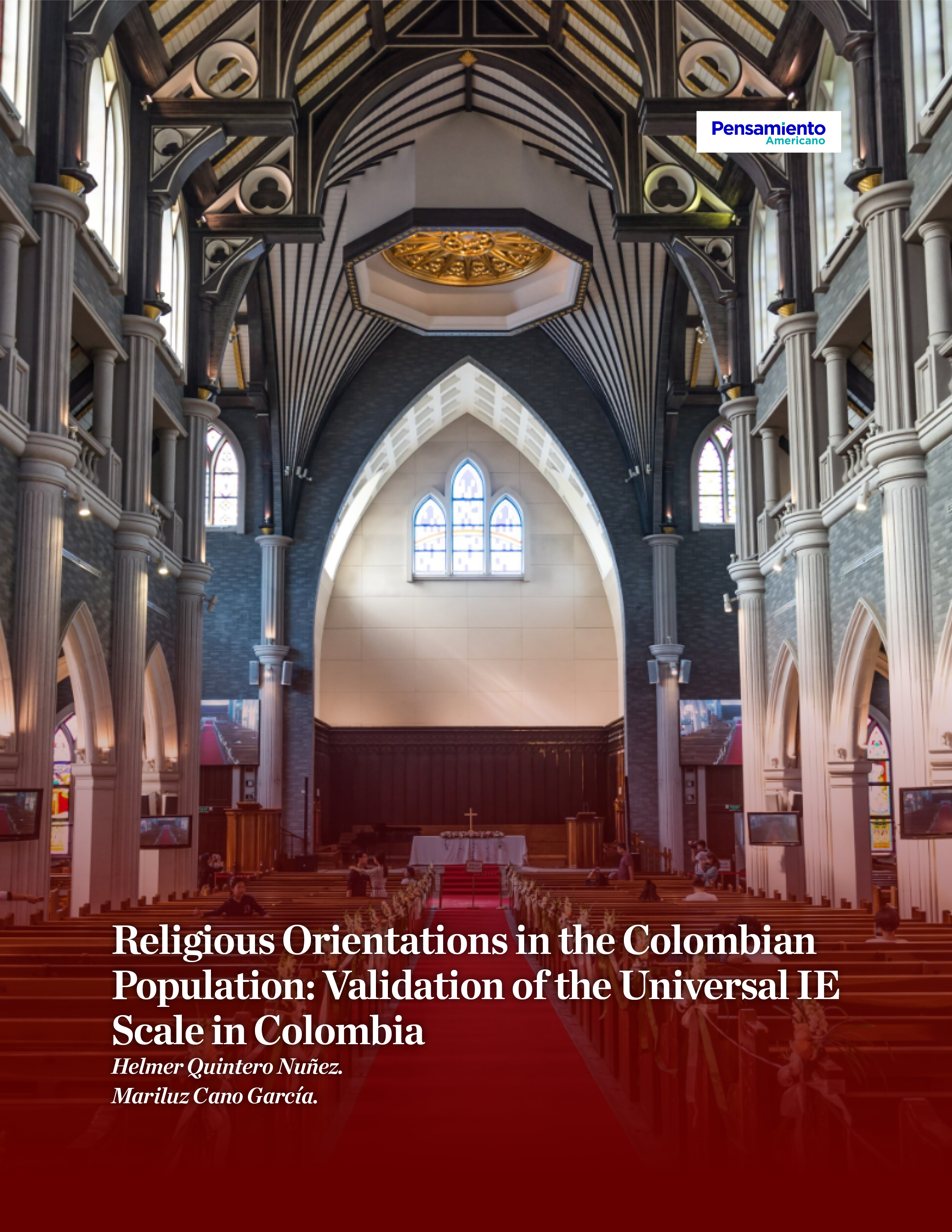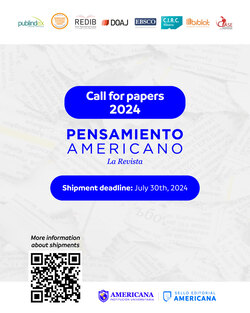Religious Orientations in the Colombian Population: Validation of the Universal IE Scale in Colombia
DOI:
https://doi.org/10.21803/penamer.18.37.830Keywords:
Age Universal IE scale, religious orientation, intrinsic religiosity, extrinsic religiosity, religious motivation, psychometricsAbstract
Introduction: The psychology of religion studies various variables, including religious orientation, initially proposed by Allport and Ross (1967). This construct distinguishes between intrinsic orientation, which reflects authentic and committed faith, and extrinsic orientation, which considers religion to be utilitarian (Kirkpatrick & Hood, 1989). Maltby (2002) developed the Age Universal IE-12 scale to measure religious orientation, which has been adapted and validated in different countries, such as the United States, Greece, England, and Ireland (Darvyri et al., 2014; Maltby, 1999). Objective: This study aimed to evaluate the psychometric properties of the Age Universal IE-12 scale in a Colombian sample to determine its reliability and validity in this context. Methodology: We included 201 participants from different religious groups: Adventists (25.4%), Catholics (49.3%), and Pentecostals (25.4%), of whom 38% were men and 62% were women. The Age Universal IE-12 scale (Maltby, 2002) was administered, and exploratory and confirmatory factor analysis was performed to evaluate its psychometric properties. Results: Exploratory factor analysis revealed a three-factor structure, explaining 72% of the variance, with a Cronbach’s alpha of 0.82. Confirmatory factor analysis showed that all fit indices supported the proposed model. Conclusions: The scale demonstrated reliability and validity consistent with findings.
Downloads
References
Acosta Cruzado, R., & Sánchez Sánchez, J. (2017). Religiosidad y depresión en adultos mayores institucionalizados de Lima Metropolitana. Salud and Sociedad, 8(1), 22–34. doi:10.22199/S07187475.2017.0001.00002.
Allport, G. W. (1950). The individual and his religion: A psychological interpretation. Macmillan.
Allport, G. W. (1966). The religious context of prejudice.Journal for the Scientific Study of Religion, 5(3), 447–457. Retrieved from www.jstor.org/stable/1384172. doi:10.2307/1384172.
Allport, G. W., & Ross, J. M. (1967). Personal religious orientation and prejudice. Journal of Personality and Social Psychology, 5(4), 432–443. doi:10.1037/0022-3514.5.4.432, PubMed: 6051769.
Batson, C. D., Flink, C. H., Schoenrade, P. A., Fultz, J., & Pych, V. (1986). Religious orientation and overt versus covert racial prejudice. Journal of Personality and Social Psychology, 50(1), 175-181. doi:10.1037/0022-3514.50.1.175.
Batson, C. D., Schoenrade, P., & Ventis, W. L. (1993). Religion and the individual: A socialpsychological perspective. Oxford University Press.
Beltrán, C. W. M. (2013). Pluralización religiosa y cambio social en Colombia. Theologica Xaveriana, 63(175), 57-85.
Bentler, P. M., & Bonett, D. G. (1980). Significance tests and goodness of fit in the analysis of covariance structures. Psychological Bulletin, 88(3), 588-606. doi:10.1037/0033-2909.88.3.588.
Bollen, K. A. (1989). Structural equations with latent variables. doi:10.1002/9781118619179. John Wiley and Sons, Inc.
Brussino, S., & Etchezahar, E. (2015). Dimensiones del autoritarismo, centralidad de la religión y orientaciones religiosas: diferencias en el análisis lineal y no lineal de sus relaciones. Actualidades En Psicología, 29(118), 73-82.
Chiavenato, I. (1967). Administración de recursos humanos. Bogotá. McGraw-Hill.
Choi, Y. M., Kim, Y. M., Lee, J. H., & Lee, G. C. (2002). A preliminary study for the development and the standardization of Korean version of the intrinsic/Extrinsic Religious Orientation Scale. Journal of Korean Neuropsychiatric Association, 41, 1197-1206.
Darvyri, P., Galanakis, M., Avgoustidis, A. G., Pateraki, N., Vasdekis, S., & Darviri, C. (2014). The revised intrinsic/extrinsic religious orientation scale in a sample of Attica’s inhabitants. Psychology, 05(13), 1557-1567. doi:10.4236/psych.2014.513166.
Dawkins, R. (2017). El espejismo de Dios. Barcelona: Espasa Libros.
Deci, E. L., & Ryan, R. M. (1985). Intrinsic motivation and self-determination in human behavior. New York: Plenum Press.
Ellis, A. (1986). The case against religion: A psycotherapist´s view and the case against religiosity. American Atheist Press.
Flere, S., & Lavrič, M. (2008). Is intrinsic religious orientation a culturally specific American Protestant concept? The fusion of intrinsic and extrinsic religious orientation among non-Protestants. European Journal of Social Psychology, 38(3), 521-530. doi:10.1002/ejsp.437.
Francis, L. J., Village, A., & Powell, R. (September 13, 2016). Religious experience and religious motivation among Catholic and mainstream Protestant churchgoers in Australia: testing and applying five short measures. Mental Health, Religion and Culture, 19(8), 932-942. doi:10.1080/13674676.2016.1216532.
Gonçalves, B., Fagulha, T., & Sousa Ferreira, A. (2016). Intrinsic and extrinsic religious orientation in Portuguese Catholics. Mental Health, Religion and Culture, 19(8), 897-910. doi:10.1080/13674676.2017.1293627.
González Villanueva, M., & Reyes Lagunes, I. (2015). Orientación Religiosa, Identidad Grupal y Religiosidad como Predictores del Fundamentalismo Religioso. Acta De Investigación Psicológica, 5(2), 1984-1995. doi:10.1016/S2007-4719(15)30018-1.
Gorsuch, R. L., & McPherson, S. E. (1989). Intrinsic/extrinsic measurement: I/E-revised and single-item scales. Journal for the Scientific Study of Religion, 28(3), 348-354. doi:10.2307/1386745.
Gorsuch, R. L., & Venable, G. D. (1983). Development of an "age universal" I-E Scale. Journal for the Scientific Study of Religion, 22(2), 181-187. doi:10.2307/1385677.
Herzberg, F. (1959). The motivation to work. Wiley.
Homan, K. J., & Boyatzis, C. J. (2010). Religiosity, sense of meaning, and health behavior in older adults. International Journal for the Psychology of Religion, 20(3), 173–186. doi:10.1080/10508619.2010.481225.
Kaldestad, E., & Stifoss-Hanssen, H. (1993). Standardizing measures of religiosity for Norwegians. International Journal for the Psychology of Religion, 3(2), 111-124. doi:10.1207/s15327582ijpr0302_5.
Kirkpatrick, L. A. (1989). A psychometric analysis of the Allport-Ross and Feagan measures of intrinsic-extrinsic religious orientation. En M. L. Lynn & D. O. Moberg (Eds.), Research in the social scientific study of religion, 1. JAI Press.
Lavrič, M., & Flere, S. (2011). Intrinsic religious orientation and religious rewards: an empirical evaluation of two approaches to religious motivation. Rationality and Society, 23(2), 217-233. doi:10.1177/1043463111404670.
Maltby, J. (1999). The internal structure of a derived, revised, and amended measure of the religious orientation scale: the 'age-universal' I-E Scale - 12. Social Behavior and Personality, 27(4), 407-412. doi:10.2224/sbp.1999.27.4.407.
Maltby, J. (2002). The age universal I-E Scale-12 and orientation Toward religion: confirmatory factor analysis. Journal of Psychology, 136(5), 555-560. doi:10.1080/00223980209605550, PubMed: 12431038.
Maltby, J. (2005). Protecting the sacred and expressions of rituality: examining the relationship between extrinsic dimensions of religiosity and unhealthy guilt. Psychology and Psychotherapy, 78(1), 77-93. doi:10.1348/147608305X39644, PubMed: 15826407.
Maltby, J., & Day, L. (2002). Religious experience, religious orientation and schizotypy. Mental Health, Religion and Culture, 5(2), 163-174. doi:10.1080/13674670210144103.
Maltby, J., & Lewis, C. A. (1996). Measuring intrinsic and extrinsic orientation toward religion: amendments for its use among religious and nonreligious samples. Personality and Individual Differences, 21(6), 937-946. doi:10.1016/S0191-8869(96)00154-7.
Maslow, A. H. (1962). Toward a psychology of being. Van Nostrand Company.
Mcclelland, D. C. (1965). Toward A theory of motive acquisition. American Psychologist, 20, 321-333. doi:10.1037/h0022225, PubMed: 14323512.
Mora, L. E., Stavrinides, P., & McDermut, W. (2014). Religious fundamentalism and religious orientation Among the Greek Orthodox. Journal of Religion and Health, 53(5), 1498-1513. doi:10.1007/s10943-013-9734-x, PubMed: 23716083.
Pierre, J. (2001). ¿Fe o espejismo? En el cruce de la religión y la psicosis. Revista Práctica de Psiquiatría, 7(3), 163-172.
Rivera-Ledesma, A., Zavala Jiménez, S., & Montero-López, M. (2016). Validación de la Age Universal I-E Scale en sujetos mexicanos. Universitas Psychologica, 15(4), 15-14.vaus, doi:10.1114/Javeriana.upsy.
Shaw, A., & Joseph, S. (2004). Principal components analysis of Maltby and Day's (1998) amended quest religious orientation scale: A replication of the three component structure. Personality and Individual Differences, 37(7), 1425-1430. doi:10.1016/j.paid.2004.01.012.
Simkin, H., & Etchezahar, E. (2013). Las Orientaciones Religiosas Extrínseca e Intrínseca: validación de la “Age Universal” I-E Scale en el Contexto Argentino. Psykhe, 22(1).
Steiger, J. H., & Lind, J. C. (1980). Statistically-based tests for the number of common factors. Paper presented at the annual meeting of the Psychometric Society, Iowa City, IA.
Tucker, L. R., & Lewis, C. (1973). A reability coefficient for maximum likelihood factor analysis. Psychometrika, 38(1), 1-10. doi:10.1007/BF02291170.
Woolfolk, A. (2006). Psicología educativa. Pearson Educación.

Downloads
Published
Issue
Section
License
Copyright (c) 2025 Pensamiento Americano

This work is licensed under a Creative Commons Attribution-NonCommercial-NoDerivatives 4.0 International License.
The author or authors of an article accepted for publication in the Journal Pensamiento Americano will transfer all of the patrimonial rights to the American University Corporation free of charge, within which are included: the right to edit, publish, reproduce and distribute both print media as digital, in addition to include in article in international indexes and / or databases, likewise, the Editorial Seal is authorized to use the images, tables and / or any graphic material presented in the article for the design of covers or posters from the same magazine. By assuming the patrimonial rights of the article, it may not be partially or totally reproduced in any printed or digital media without its express permission.
AUTHORITY ASPECTS
For the Pensamiento Americano Journal, all the authors of an article have made substantial contributions to the research and the manuscript, and they share the responsibility when the article presents errors, fraud in some way or violations of copyright.
After submitting an article, the journal does not accept the addition, deletion or change in the order of the authors, in addition we reserve the right to release the article when it has been submitted to the journal and under no circumstances will American Thought accept the article. withdrawal of an article during any phase of the editorial process





